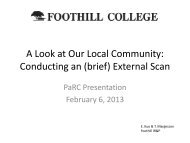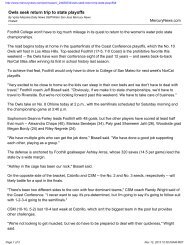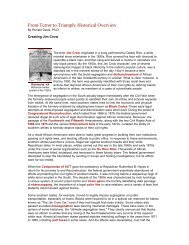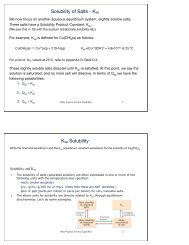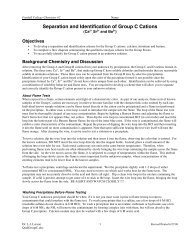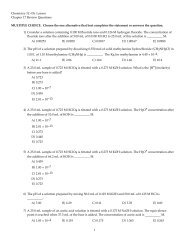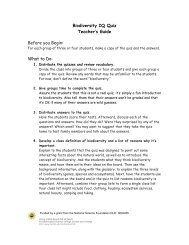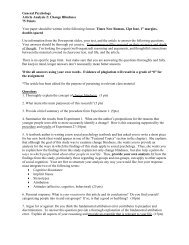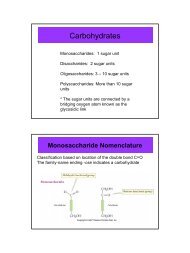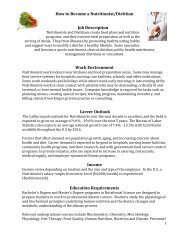Quiz 1
Quiz 1
Quiz 1
You also want an ePaper? Increase the reach of your titles
YUMPU automatically turns print PDFs into web optimized ePapers that Google loves.
<strong>Quiz</strong> 1<br />
Answer all questions on the scantron by filling in the bubble<br />
completely. Scantrons will not be regraded.<br />
1. Scientific theories are tested and validated with experimentation.<br />
A)True B) False<br />
2. The statement “ Osmium has a density of 22.9 g/cm 3 “ is an example of<br />
A) law B) hypothesis C) theory D) observation<br />
3.What is the standard SI unit for length?<br />
A) mile B) centimeter C) foot D) meter E) none of the above<br />
4. How many significant figures are in 0.00500670?<br />
A) 3 B) 5 C) 6 D) 8 E) 9<br />
5. Convert 3.23 x 10 3 to decimal notation.<br />
A) 3.23 B) 32.3 C) 323 D) 0.00323 E) 3230<br />
6. Rounded correctly, the product of: 2.000 cm X 10.0 cm is<br />
A) 20.00 cm 2 B) 20.0 cm 2 C) 20 cm 2 D) 20.000 cm 2<br />
E)none of the above<br />
7. Rounded correctly, the result of: (23.1000 g - 22.0000 g) / (25.10 mL - 25.00 mL) is:<br />
A) 11.00 g/mL B) 11 g/mL C) 11.000 g/mL D) 11.0 g/mL<br />
E) none of the above<br />
8. Total U.S farmland occupies 954 million acres. How many sq miles is this?<br />
[1 acre = 43,560 ft 2 , 1 mi = 5280 ft]<br />
A) 1.16 X 10 21 mi 2 B)1.49X10 6 mi 2 C)6.11X10 11 mi 2 D)7.87X10 9 mi 2<br />
E) none of the above<br />
9. Which of the following is a frequently used unit for the density of liquids and solids?<br />
A) g/L B) g/kg C) kg/L D) cm 3 /mL E) g/cm 3<br />
10. Calculate the mass of lead cube, which has a density of 11.4 g/mL and displaces 20.1 mL of<br />
water?<br />
A) 230 g B) 229 g C)229.2 g D) 1.76 g E) none of the above
11. The length of a piece of glass tubing is 0.525 m. How many inches long is the tubing?<br />
[2.54 cm = 1 inch]<br />
A) 0.0133 inches B) 0.207 inches C)20.7 inches D) 52.5 inches E)none of the<br />
above<br />
12. What is the density of a sample of mineral oil if 250 mL has a mass of 0.23 kg?<br />
A) 0.0092 g/mL B)0.92 g/mL C)5.8 g/mL D)10.9 g/mL<br />
E) none of the above<br />
<strong>Quiz</strong> 2<br />
PART A: MULTIPLE CHOICE<br />
1. Which state of matter has indefinite shape and is compressible?<br />
A) liquid<br />
B) solid<br />
C) gas<br />
D) plasma<br />
E) none of the above<br />
2. A salt (NaCl) solution is an example of a (an)<br />
A) pure substance<br />
B) element<br />
C) compound<br />
D) homogeneous mixture<br />
E) heterogeneous mixture<br />
3. Which of the following items is a chemical property?<br />
A) the paint color on a new red car<br />
B) the odor of spearmint gum<br />
C) the melting and boiling point<br />
D) the tarnishing of a copper statue<br />
E) none of the above<br />
4. Convert 95.0 kWh to (food) Calories. ( 1 cal = 4.184 J and 1 kWh = 3.60 x 10 6 J.)<br />
A) 8.17 x 10 3 Cal<br />
B).8.17 x 10 4 Cal<br />
C) 8.17 x 10 7 Cal<br />
d) 1.43 x 10 7 Cal<br />
E) 1.43 x 10 9 Cal<br />
5. Which of the following elements will have the most similar chemical properties as<br />
potassium?
A) Ca<br />
B)Ar<br />
C)Fe<br />
D)Na<br />
E)C<br />
A) Electron<br />
B) Neutron<br />
C) Proton<br />
D) two of the above<br />
E) all of the above<br />
6. Which of the following subatomic particles has the least mass?<br />
7. The names of the elements whose symbols are Si, P, Mg, S are respectively:<br />
A) silicon, potassium, magnesium, and sulfur<br />
B) silver, phosphorus, magnesium, and sulfur<br />
C) silicon, phosphorus, manganese, and sulfur<br />
D) silicon, phosphorus, magnesium, and sulfur<br />
E) silicon, phosphorus, magnesium, and sodium<br />
8. Which one of the following is a period 3, group 4A metalloid?<br />
A) B<br />
B) Si<br />
C) Ge<br />
D) P<br />
E) none of the above<br />
9. The nucleus of a 19 9F atom contains:<br />
A)19 protons and 19 electrons<br />
B)19 protons and 0 electrons<br />
C) 9 protons and 10 electrons<br />
D) 19 protons and 19 neutrons<br />
E) 9 protons and 10 neutrons<br />
10. What is the symbol of an ion that has 12 protons and 10 electrons?<br />
A) Si 2+<br />
B) Si<br />
C) Mg 2+<br />
D) Ne<br />
E) Ne 2–<br />
11. How many electrons are in the bromide ion, Br – ?<br />
A) 35<br />
B) 36<br />
C) 46<br />
D) 70<br />
E) 8<br />
PART B : SHOW ALL WORK IN THE SPACES PROVIDED. USE UNITS AND<br />
SIGNIFICANT FIGURES IN YOUR CALCULATIONS. CIRCLE YOUR FINAL<br />
ANSWER.
1. Calculate the quantity of heat required to raise the temperature of a 250.0 mL cup of coffee by<br />
75.1 o C. Density of coffee is 1.00 g/mL and specific heat of coffee is 4.184 J/g. o C.<br />
2. Carbon has three naturally occurring isotopes: C-12 with mass 12.000 amu and a natural<br />
abundance of 98.89%, C-13 with mass 13.004 amu and a natural abundance of 1.110%, and C-<br />
14 which is negligibly small (assume 0% abundance). Calculate the atomic mass of carbon.<br />
<strong>Quiz</strong> 3<br />
Mark your choices on the scantron by filling in the bubbles clearly<br />
using a pencil. Erase your changes completely. Scantrons cannot be<br />
regraded. Write your name and section number on the scantron.<br />
1. The limiting reactant is always the reactant with the least mass<br />
A) True B) False<br />
2. According to the following reaction, 2 moles of hydrogen gas react with one mole of oxygen<br />
gas to produce 2 moles of water. 2H2 + O2 → 2H2O A) True B) False<br />
3. Assuming that temperature and pressure are constant, the volume of a gas is inversely<br />
proportional to the number of moles.<br />
A) True B) False<br />
4. At approximately room temperatures and pressures, real gases will follow the model of kinetic<br />
molecular theory and behave as ideal gases.<br />
A) True B) False<br />
5. STP conditions are 273 K and 760 mm Hg.<br />
A) True B) False<br />
6. Determine the excess reactant for the reaction below, if you start with 10.0 g of Na and<br />
10.0 g of Cl2?<br />
2Na + Cl2 → 2NaCl<br />
A) Na B) Cl2 C) NaCl D) both Na and Cl2 E) none of the above<br />
7. Calculate the actual yield (in grams) of a reaction if 28.4 grams is the maximum amount<br />
produced from a reaction that has 88.0% yield?<br />
A) 25.0 B) 22.0 C) 3.52 D) 352 E) none of the above
8. All of the following statements are consistent with the kinetic molecular theory of gases<br />
EXCEPT<br />
A) The size of the gas molecules is negligible compared to the total volume of the gas.<br />
B) Gases have a low density because there is so much empty space between the particles.<br />
C) The gas molecules collide with each other and with the surfaces around them.<br />
D) Strong attractive forces hold the gas molecules together.<br />
E) Gases assume the shape and volume of their container because they are in constant, straightline<br />
motion.<br />
9. A 3.76 g sample of an inert gas is stored in a 2.00 L vessel at 874 torr and 25 °C. Calculate the<br />
molar mass of the gas?<br />
A) 4.00 B) 20.2 C) 40.0 D) 32.0 E) not enough<br />
information<br />
10. Oxygen gas reacts with powdered aluminum according to the following reaction.<br />
4Al + 3O2 → 2Al2O3 Calculate how many liters of O2 gas, measured at 782 mm Hg and 25 o C, are required to<br />
completely react with 64.8 g of Al?<br />
A) 22.4 L B) 42.8 L C) 45.4 L D) 21.0 L E) not enough information<br />
11. A sealed container contains 1.0 mol of hydrogen and 2.0 moles of nitrogen gas. If the total<br />
pressure in the container is 1.5 atm, what is the amount of pressure exerted by each gas?
A) H2 = 1.0 atm and N2 = .50 atm B) H2 = 0.50 atm and N2 = 1.0 atm<br />
C) H2 = 1.0 atm and N2 = 2.0 atm D) H2 = 2.0 atm and N2 = 1.0 atm<br />
E) not enough information
Chem 25; W10_Lecture <strong>Quiz</strong> 1 Name______________________________________<br />
7




